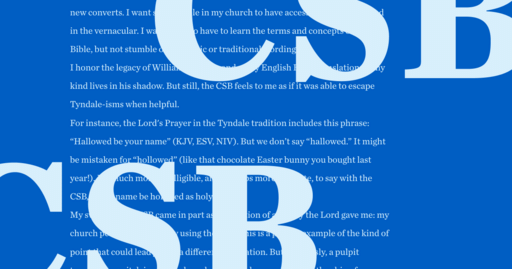Almost two years ago, I switched to the Christian Standard Bible (CSB) as my primary preaching and teaching translation for my church, Mercy Baptist Church in West Chester, Ohio. Last year I led our church to purchase CSB pew Bibles (though we use chairs!).
Why did I switch to the CSB instead of to another good translation (e.g., ESV, NASB)—or just stick with the good one I was using (NIV 2011)?
I’m going to give you my top reasons, but not because I want to cheer on “Team CSB.” You may use similar principles to arrive at a different conclusion, and that’s fine. I don’t think there is one best translation of the Bible.
1. The CSB is an accurate translation
I said “an accurate translation” because I want to insist again that there are numerous other translations that are also worthy of the adjective “accurate.” I am convinced, in fact, that each of the major evangelical English translations is good enough for preaching and teaching, though each has strengths and weaknesses.
For instance, I preached expository sermons from the NIV every week for years, and I had a great experience. Very frequently, its rendering of a particular word or phrase was exactly how BDAG, the standard Greek-English lexicon, defined that word or phrase.
The CSB is accurate, too—maybe even a bit more accurate than the NIV.
One minor example I ran across during a recent sermon series in Mark. Mark 9 in the CSB says that Jesus’s clothes on the Mount of Transfiguration “became dazzling—extremely white as no launderer on earth could whiten them.” This is minor, but the ESV and NIV say “no one” and “anyone,” respectively. I appreciated the CSB’s attention to detail here (cf. NASB, NET, NKJV, and BSB).
2. The CSB is a readable translation
The CSB is a modern English translation that is suitable for adult church members but also for children, those who speak English as a second language, and new converts. I want such people in my church to have access to the Word of God in the vernacular. I want them to have to learn the terms and concepts of the Bible, but not stumble over archaic or traditional wording.
I honor the legacy of William Tyndale, and every English Bible translation of any kind lives in his shadow. But still, the CSB feels to me as if it was able to escape Tyndale-isms when helpful.
For instance, the Lord’s Prayer in the Tyndale tradition includes this phrase: “Hallowed be your name” (KJV, ESV, NIV). But we don’t say “hallowed.” It might be mistaken for “hollowed” (like that chocolate Easter bunny you bought last year!). It’s more intelligible, and perhaps more accurate, to say with the CSB, “Your name be honored as holy.”
3. The CSB was already being used in my church
My switch to the CSB came in part as a reflection of a reality the Lord gave me: my church people were already using the CSB. This is a perfect example of the kind of point that could lead you to a different translation. But, obviously, a pulpit translation switch is easier when church people were on board the ship of a different translation even before you were!
My church isn’t unique statistically: in the last few years, the CSB has risen to become one of the top six English Bible translations, according to the ECPA‘s statistics.
4. The CSB has a good reputation
Some joke that CSB stands for “Cool Southern Baptist” translation, but that remains a joke. The CSB website explains there were over a hundred scholars from seventeen denominations who worked to bring the CSB and its predecessor (the HCSB) into existence.
Maybe the CSB will one day provoke some kind of opposition. But CSB leadership made wise translational and promotional decisions, apparently, and so far the CSB seems to me to have avoided creating a party of critics.
For instance, regarding wise translational decisions, the CSB’s editors opted to follow the Colorado Springs Guidelines in its mild use of gender-inclusivity.
5. The CSB strikes a good balance in what it tells readers
Often when formal equivalent translations give their rendering of a difficult word or phrase, they give no help as to what that phrase might mean functionally (such as “cleanness of teeth” [Amos 4:6] and “the way of women” [Gen 31:35]).
On the other hand, translations on the functional side of the equivalency scale often don’t tend to use the footnotes to give the reader a more formal rendering.
On the third hand (!), there’s the NET Bible, which floods readers with forty thousand (helpful) translators’ notes!
The CSB does a good job balancing what the reader needs to know with the reader’s need to keep reading. They give the formal rendering if at all possible, but if not possible, they’ll give a functional rendering, often with a footnote about the formal translation.
6. The CSB comes in multiple editions
There are an increasing number of formats and settings available in the CSB: portable editions, large-print editions, study Bibles (like those below)—and, of course, full-featured digital editions.
Holman has even entered the premium Bible market with their Handcrafted Bibles series. I have owned two of the Handcrafted series Bibles—the CSB Wide-Margin Verse-by-Verse and the CSB Study Bible—and they are sturdy yet elegant.
Conclusion
Perhaps it would be ideal to have one translation every Christian uses for every purpose: reading, teaching/preaching, memorizing, study, discipleship. This is the way things were with the KJV for a long time.
But I’m actually grateful that we do not live in that world anymore. I think we live in a golden era of evangelical English Bible translation. Each translation has its own nuanced approach to Bible translation, and we are the recipients of their diligent work.
The NIV is still my personal favorite for reading, but I am glad I switched to the CSB for preaching and teaching at my church.








